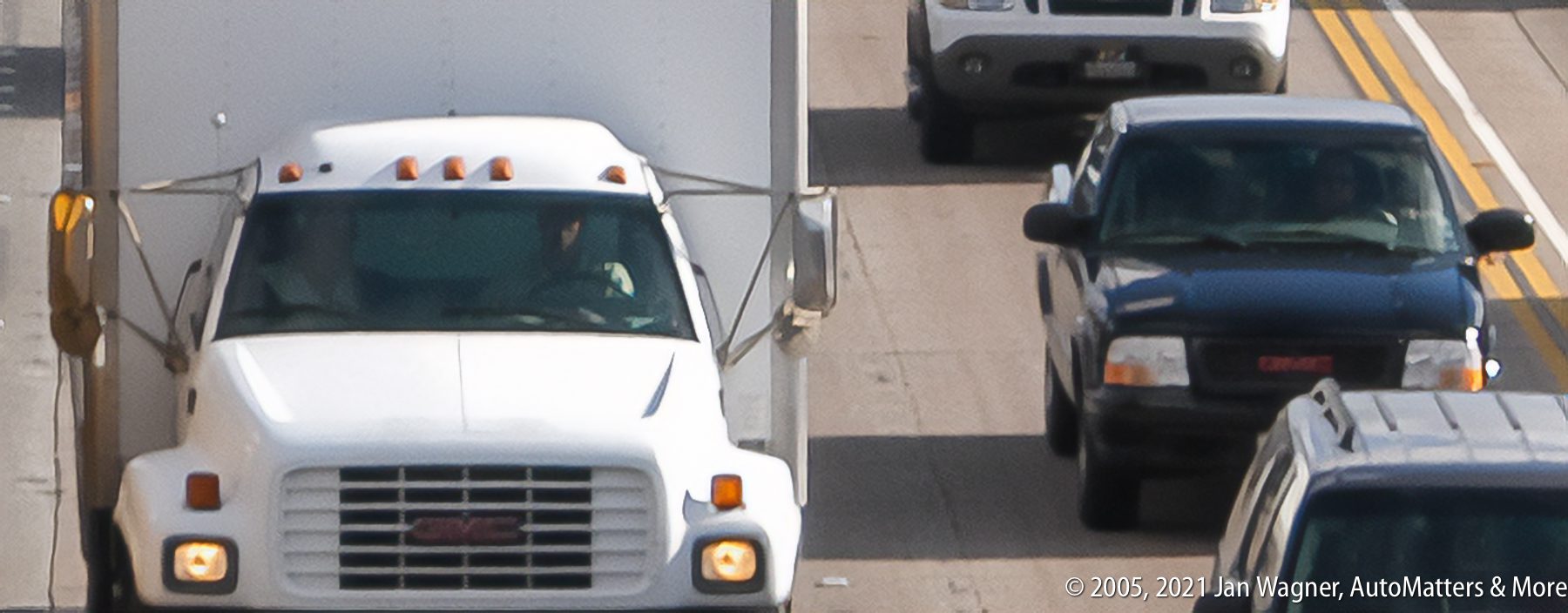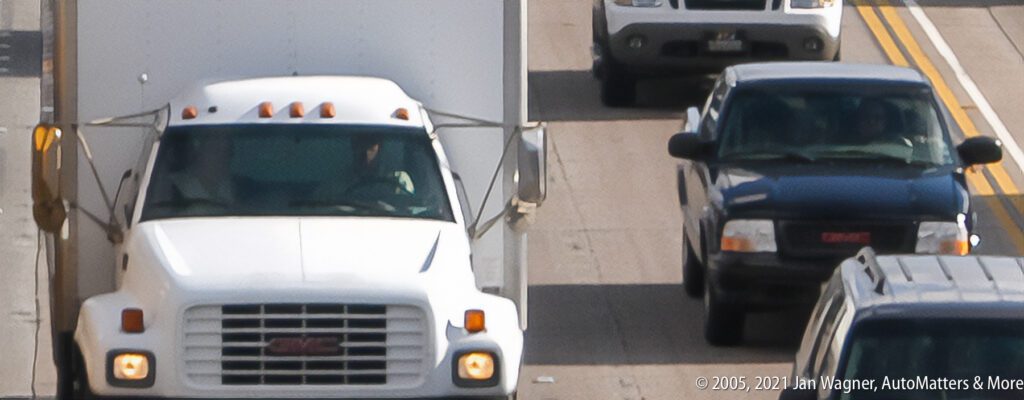
Blind Spots, Trucks and SUVs

On a crowded freeway a few days ago, a fellow member of the San Diego Miata Club had a run-in with a catering truck. According to one account of the accident, the catering truck started to change lanes and sideswiped the Miata. Then, realizing what had happened, the truck’s driver overcorrected, lost control, careened off of the center guardrail and rolled over, hitting other vehicles. In the meantime, the damaged Miata spun around, briefly faced oncoming traffic and then safely came to a stop. There were injuries but considering what might have happened, it was a miracle that no one was killed.
It is a fact that cars, especially Miatas, are smaller and lighter than big trucks. That contributes to the Miata’s superior handling but significant crash damage if the two collide.
What caused this accident? Perhaps it was due to a blind spot.
A serious problem with trucks and SUVs, which affects everyone near them, is that they have big blind spots. Tractor trailers – also known as big rigs, have some huge blind spots. That means that even with the best efforts of their drivers, if a car is in one of their blind spots they cannot see them. That is a scary thought, because if the truck or SUV driver doesn’t know someone is there, they might change lanes and accidentally hit them or force them off of the road. Add in the possibility of inattentiveness on the part of one or both of the drivers involved and the situation can become even worse.
I learned a lot about blind spots at the official website of the Pennsylvania Department of Transportation, where an illustration shows the four distinct blind spots of a typical big rig. The American Trucking Association (ATA), through their “Share The Road” campaign, wants to get this important safety message out to everyone.

Moving counterclockwise around a truck, the first blind spot is relatively small, on the driver’s left side. It extends from about where the driver is seated behind the wheel to a little bit back of the truck’s cab.

The next blind spot is much bigger. It is similar to what you may have seen recently in a safety piece on TV about SUVs. That blind spot extends way back behind a truck, and is about the same length as the truck itself. In the TV piece, a bunch of little kids were standing behind the SUV but from inside the driver could not see any of them. If you are driving in this area, you cannot be seen either, unless the truck or SUV has a rear view camera. Furthermore, if you are following that close you can’t possibly see what is going on in traffic up ahead. If that traffic suddenly slows, you will have very little warning.

The third blind spot is huge. It is on the passenger side of a truck. Not only is it long, but it is very wide also, extending several lanes to the right of the truck. If a car is passing a big rig in any of the lanes to its right, it may not be seen by the driver of the truck. Furthermore, this big, dangerous blind spot does not just occur to trucks and SUVs. Even small cars can and do have this problem. For example, I drive a Toyota Prius and it has a very big blind spot to my right. More than once I’ve started to change lanes – after carefully checking for traffic beside me and seeing none, only to then see someone there after all when I started to move over. Be very careful if you’re to the right of any vehicle, because its driver may not be able to see you.

Here’s something that should help you learn where these blind spots are. If you look into the outside mirrors of a truck and cannot see the driver’s face, he probably cannot see you either.
Finally the last blind spot – especially on a big rig, is where you might least expect it to be. It is directly in FRONT of the truck. Big trucks are very tall, and their hoods are often long. Visualize an imaginary straight line that goes from the eyes of the driver, touches the end of the hood and continues on to the point where it intersects with the road in front of the truck. Anything below the line and behind that point cannot be seen by the truck driver.

If someone driving a small car cuts right in front of a truck and then has to suddenly slow down or, worse yet, stop for something in front of them, the danger goes up even further. The truck, which might weigh 80,000 pounds, could need the length of a football field to stop under ideal conditions, but because of the blind spot at the front, the truck’s driver might not immediately notice a car directly in front of them. Under those combined circumstances, the chance of slowing down quickly enough to avoid plowing into the car could be slim.
Remembering an important rule of thumb will help to reduce the risk of this happening. When passing a vehicle wait until you can see the entire front end of that vehicle in your rearview mirror before you pull in front of them. If you are in front of a big truck and its grille and lights fill your mirrors, you’re probably too close.

Here is something else to remember. Keep right except to pass, and pass on the left. That will keep you out of the big blind spot to the right of trucks.

Consider this, too. According to Cameron Moore, President and CEO of the Northeastern Pennsylvania Alliance, “You can’t linger. Drivers must quickly pass these blind spots to get out of a potentially life-threatening situation.”
Following this good advice sounds easy enough, but in reality that is sometimes not possible. What if the truck that you want to pass is moving at close to the speed limit? If you try to pass while maintaining the legal speed limit, you will not be able to get by quickly.
In another scenario, what if there is other traffic in the lane in front of you, beside the truck that you’re trying to pass? Again, you cannot get by quickly because your way is temporarily blocked. If you wait until the traffic ahead of you clears the truck before you start to pull alongside, you will then be able to pass the truck more quickly – unless other traffic changes to the lane in front of you and fills up the available space.
According to the U.S. Department of Transportation: “About 75 percent of all truck-related car fatalities are attributed to an action by the car driver – and 35 percent of them occur in the blind spots around trucks.” Driver education can help to reduce this percentage.

For more information, do what I did and go tohttp://www.dot.state.pa.us/penndot/districts/district4.nsf/040301-s1-nozones.htm.
Please drive safely and do join me again next time.


